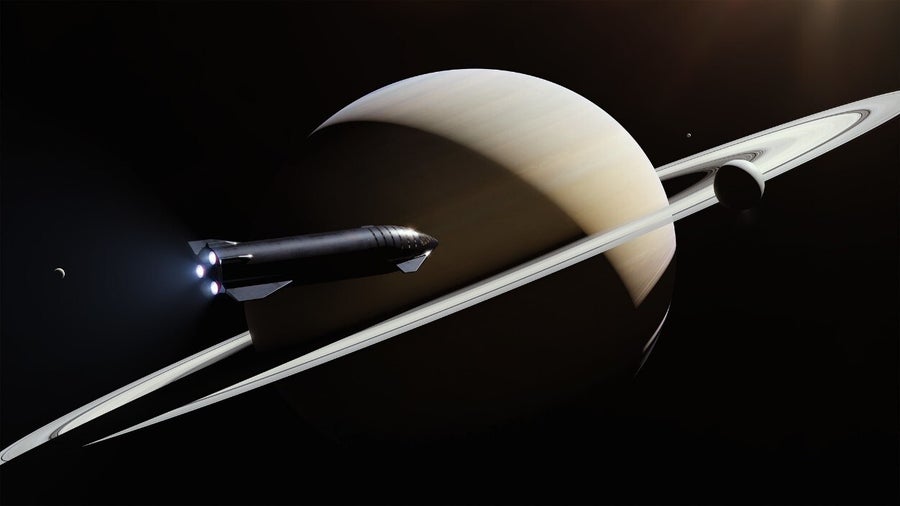
Render of Starship approaching Saturn Image credit: SpaceX
According to SpaceX's Founder and CEO , Starship could potentially generate artificial gravity by spinning the spacecraft to create centrifugal force. This concept, which has been a staple in science fiction, is based on real physics principles and could be applied to long-duration space missions to mitigate the adverse effects of prolonged weightlessness or microgravity on human health.
Elon Musk has mentioned that Starship could have a "small spin" on its way to Mars to provide a gravity vector. The idea is that by rotating the spacecraft or a section of it, the centrifugal force would push the occupants toward the outer edge, simulating the effects of gravity. However, there are challenges associated with this, such as the need for a large structure to spin at a reasonable rate to generate sufficient force, and the potential for motion sickness due to the Coriolis effect.
Physics of Artificial Gravity
Artificial gravity is not actual gravity but an inertial force indistinguishable from gravity in terms of its action on mass. It's created aboard a space vehicle in free fall or transit to another planet by spinning the spacecraft or a centrifuge within it.
Generating Artificial Gravity
The primary method to generate artificial gravity is through rotational dynamics. As the spacecraft spins, everything inside is pushed outwards towards the walls, which would be designed to function as the floor due to this outward force. This mimics the effects of gravity on the body (similar to the sensation on a spinning ride at an amusement park.), allowing astronauts to walk and move normally.
Considerations and Challenges
However, implementing this in a spacecraft comes with several challenges:
- Centrifugal Force: This force is directly proportional to the distance from the axis of rotation, meaning the "gravity" varies with the radial distance from the centre.
- Coriolis Effect: As people move within the rotating environment, they may experience the Coriolis Effect, which can cause disorientation and nausea.
- Engineering Constraints: The design of such systems must consider suitable building materials, spacecraft mass, power, and cost limitations.- Size and Rotation Speed: The spacecraft needs to be large enough so that it can rotate at a reasonable rate without causing discomfort to the astronauts. A smaller radius would require a faster spin to achieve the same effect, which could lead to motion sickness.
- Differential Gravity: The force experienced by the astronauts would differ between their feet and head, potentially leading to health issues.
- Energy and Orientation: Maintaining the correct temperature and ensuring solar cells are oriented correctly for power generation while the spacecraft is spinning can be complex.

SpaceX envisions Starship enabled cities on the Moon Image credit: SpaceX
Alternatives to Spinning
- Tethered Craft: One alternative suggested is to have two Starships tethered together, spinning around a common centre. This would allow for a larger radius and potentially a more comfortable environment.
- Acceleration: Another way to simulate gravity is through constant acceleration. By accelerating the spacecraft in one direction, the inertia creates a force similar to gravity. But this requires constant thrust thus needing a lot of propellant.
Practical Applications
While the concept has been used in simulations to train astronauts, there are no current practical outer space applications of artificial gravity for humans due to concerns about the size and cost of a spacecraft necessary to produce a useful centripetal force comparable to Earth's gravity. Although once starship is operational at its intended potential (full reusability with mammoth lift capability), it’ll readily make this whole operation cost effective and possible.
Future Prospects
Advancements in technology may eventually allow for the implementation of artificial gravity in space habitats, enhancing the feasibility of long-term human space exploration.
Current Research
SpaceX CEO Elon Musk has mentioned that Starship will have a small spin to create a gravity vector. Other companies and agencies, including Airbus and NASA, are also exploring the concept of spinning space habitats to provide artificial gravity.
In summary, while the idea of artificial gravity is still largely theoretical and in the research phase, the spinning of a spacecraft is the most feasible method currently considered for generating it in space. This will be more and more important as NASA has announced they are working with SpaceX to make space stations using SpaceX Starships.


Add comment
Comments